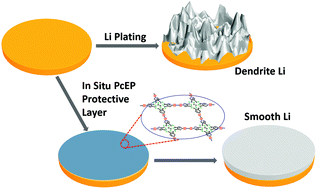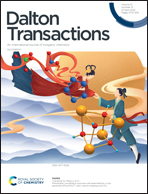Precise construction of lithiophilic sites by diyne-linked phthalocyanine polymer for suppressing metallic lithium dendrite†
Abstract
Uncontrolled growth of lithium dendrite is the key challenge that impedes the practical application of Li anodes in high-energy-density Li-metal batteries. Precisely constructing lithiophilic active sites on the anode surface is expected to be an effective strategy for promoting the anode interfacial properties and alleviating the dendrite growth of lithium. Herein, a diyne-linked phthalocyanine polymer (PcEP) with precise lithiophilic active sites is designed and constructed in a bottom-up manner in situ on the surface of the copper foil via the coupling reaction of tetraethynylphthalocyanine. The lithiophilic electron-rich pyrrolic nitrogen and aza nitrogen in the Pc structure, and the sp-hybridized carbon in the diyne linkage (–C![[triple bond, length as m-dash]](https://www.rsc.org/images/entities/char_e002.gif) C–C
C–C![[triple bond, length as m-dash]](https://www.rsc.org/images/entities/char_e002.gif) C–) in PcEP can conduct the homogeneous nucleation and deposition processes of lithium, and thus suppress the dendrite growth. This dendrite-free metallic lithium anode exhibits reduced overpotential, high coulombic efficiency (98.6%), and prolonged lifespan (200% longer than that of a Cu anode). These impressive achievements demonstrate that the advanced phthalocyanine polymer might be a promising material for addressing the critical interfacial issues related to the next-generation high-energy-density Li-metal-based storage devices.
C–) in PcEP can conduct the homogeneous nucleation and deposition processes of lithium, and thus suppress the dendrite growth. This dendrite-free metallic lithium anode exhibits reduced overpotential, high coulombic efficiency (98.6%), and prolonged lifespan (200% longer than that of a Cu anode). These impressive achievements demonstrate that the advanced phthalocyanine polymer might be a promising material for addressing the critical interfacial issues related to the next-generation high-energy-density Li-metal-based storage devices.



 Please wait while we load your content...
Please wait while we load your content...